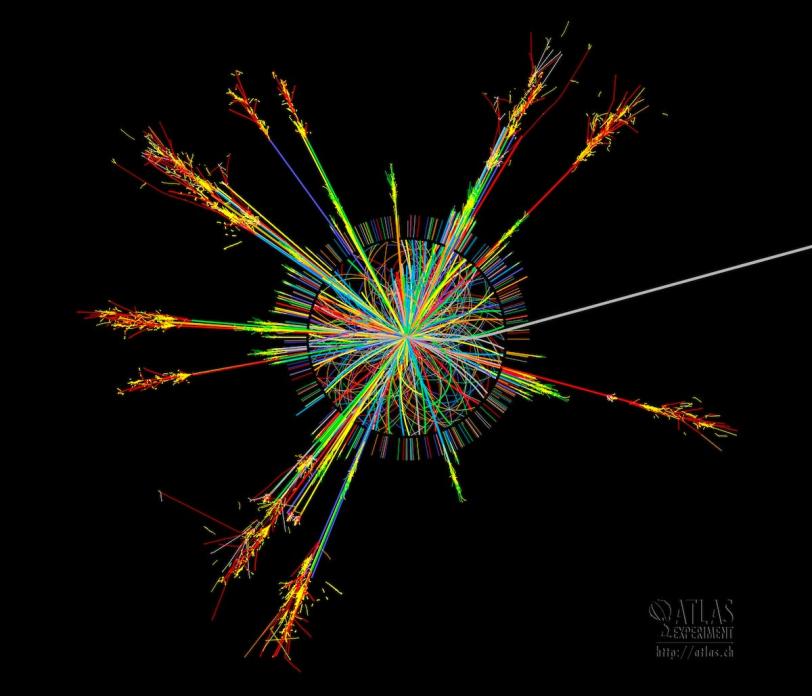Researchers Converge to Map Out a Way to Interpret Particle Collision Images
One of the most striking features of particle collisions is the jet: a spray of particles, or energy – or both – produced when hadrons, the quark-containing particles that give the Large Hadron Collider its name, slam together.
By Lori Ann White
One of the most striking features of particle collisions is the jet: a spray of particles, or energy – or both – produced when hadrons, the quark-containing particles that give the Large Hadron Collider its name, slam together. Detector images of jets resemble sprays of fireworks or colorful fountains, and hint at the magnitude of the energies unleashed – at least in relation to the quantum realm where jets flare and die, and where matter turns to energy turns to matter in an instant.
Jets are also important, if complex, windows on the behavior of matter. And, said Ariel Schwartzman, SLAC particle physicist and member of the ATLAS collaboration at the LHC, he and his colleagues may soon be able to see through the windows of jets much more clearly – even though, as Schwartzman explained, the exact dimensions of those windows are open to interpretation.
For example, an experimental physicist such as Schwartzman sees jets as tools to help analyze collisions. "A jet is the result of an algorithm," he said – a somewhat arbitrary way to group together energy trails deposited in detectors by fleeing particles.
However, grouping together all particles arising from a single collision, or event, is extremely difficult, for several reasons. As many as 400 million proton-proton collisions per second can take place in each of the CMS and ATLAS interaction points at the LHC, for starters. The vast majority of them aren't energetic enough to catch the attention of, or "trigger," the ATLAS detectors, but that doesn't stop what Schwartzman called their "soft energy" signatures from muddying the "hard energy" of the interesting jets. Schwartzman called this "in-time pileup."
Also, he added, "collisions keep happening as you gather data," resulting in "out-of-time pileup” – extraneous signals from collisions that happen either before or after a detector is triggered to start gathering data.
On the other hand, theoretical physicists see jets as actual sprays of particles – very specific sets of particles created under very specific circumstances that are precisely described by particular theories.
In order to support, or rule out, a particular theory, the theorist's specific jet of particles is compared to the experimenter's approximate jet of data to see if they match. But with all the uncertainties regarding precisely what makes up the experimenter's jet, it's like comparing apples to – something that is probably not an apple.
That, said Schwartzman, is where the experimenters at the LHC are making progress. Just last month, a workshop co-organized by Schwartzman drew about 80 members of the ATLAS Jets and Missing Energy Group to SLAC to discuss ways to clarify the experimental windows offered by jets.
"We had several discussions about the roadmap for the next year," Schwartzman said. A major goal: to improve the precision with which they measure the energies of the jets. He said they think they can reduce the uncertainty in the jet energy scales to an unprecedentedly low level through such techniques as "grooming" the jets, or identifying and subtracting the soft energies that don't belong; tagging jets, or associating them with a particular place of origin; using real data to improve simulations and simulations to improve the gathering of real data; and more.
One of the most exciting developments, according to Schwartzman, is that theorists are pushing experimental groups to look for more information in the jets themselves. "Traditionally, a jet was a four-vector," an expression of total relativistic energy and momentum, Schwartzman said. Now jets are "shape, energy distribution, structure. Even particles."
As for what Schwartzman expects to see through the widening windows of jets: "There's tremendous physics potential in these new ideas from the theory point of view – new ways of investigating jets, new ways to look at hadronic final states. It's extremely challenging from an experimental point of view." He paused. "It's extremely attractive and exciting."
It's clear Schwartzman enjoys the view.
